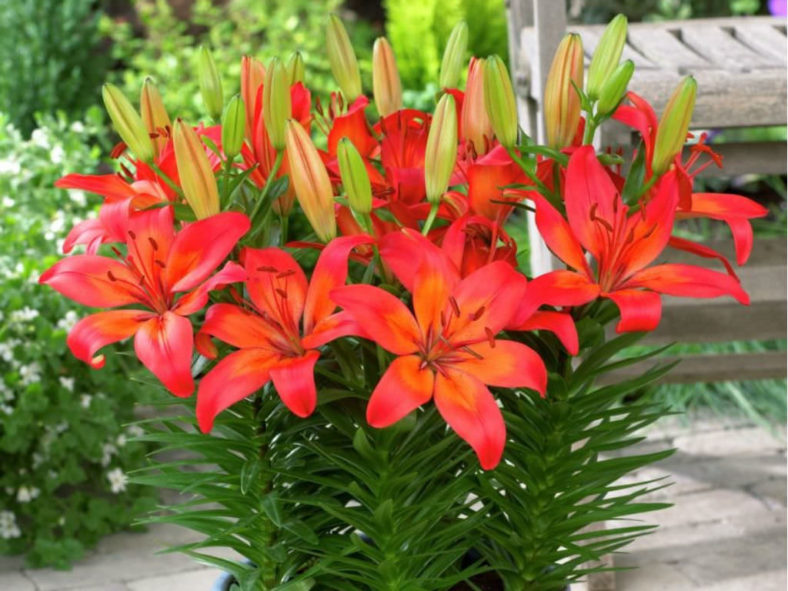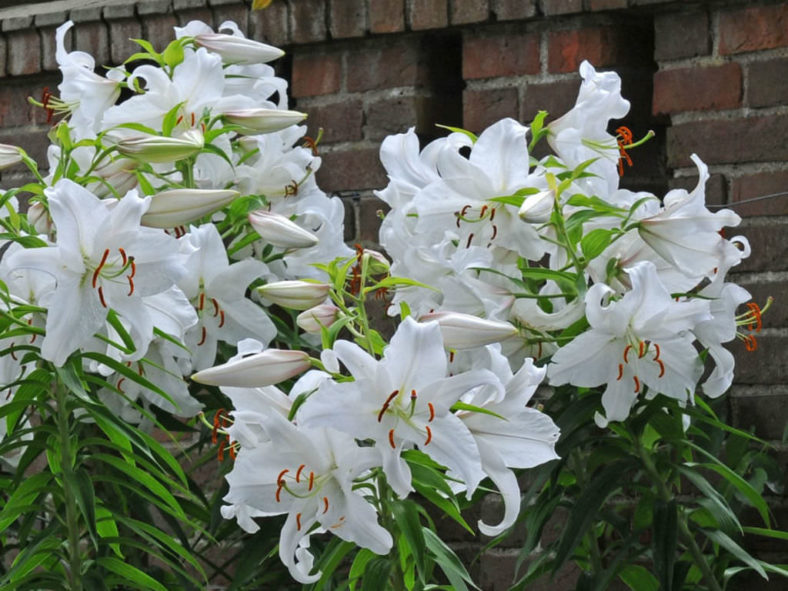Gardeners prize lilies for their dramatic flowers and long sturdy stems. Asiatic Lilies (Lilium asiatica) and Oriental Lilies (Lilium orientalis) are common lilies grown commercially and in home gardens. However, each has its appeal and growing needs, which may make one more ideal than the other for your landscape.
Asiatic Lily Identification
Asiatic Lily cultivars are classified as Division I Lilies, which grow 1 to 5 feet (30 cm to 1.5 m) tall and produce deep red, orange, rose, bright yellow, peach, cream, or white flowers. Each bloom is typically 6 to 8 inches (15 to 20 cm) in diameter, and petals are often streaked or spotted with another color. Asiatic Lilies are further separated into three subdivisions based on flower appearance. Subdivision IA Lilies bloom in June. Their flowers are upright and borne solitary or in umbels, clusters of stems on a single main branch. Lilies in subdivision IB produce outward-facing flowers in June. These flowers are often streaked with purple. Subdivision IC Asiatic Lilies have flowers borne pendant or facing downward in early July.

Oriental Lily Identification
Oriental Lilies are classified as Division VII Lilies, thriving and reaching 2 to 6 feet (60 cm to 1.8 m) tall. They bloom from July through August, with flowers 4 to 12 inches (10 to 30 cm) in diameter. Oriental Lilies may be pure white, crimson, or white splotched with red or pink, and they are divided into four subdivisions based on their flower appearance. Subdivision VIIA Lilies produce trumpet-shaped flowers, while subdivision VIIB Lilies produce bowl-shaped flowers. Subdivision VIIC Lilies produce recurved blooms, which means the petals curve outward instead of cupping inward, while lilies in subdivision VIID produce clusters of 12 to 30 flowers that have recurved petals but flat faces.

Care
Asiatic Lilies require moist, well-drained soil rich in organic material. They prefer full sun locations, but they are otherwise easy to grow because they aren't fussy about soil conditions. Oriental Lilies also like well-drained, fertile soil, but they require acidic conditions to thrive. Asiatic Lilies must be deadheaded as the flowers fade. Stems die back naturally in the fall, but groupings must be divided every 3 to 4 years. Before winter, a mulch application for both lily types keeps the roots cool and moist. Oriental Lilies tend to grow tall stems that require staking to prevent the plants from toppling over or bending. Asiatic Lilies are shorter and sturdier, so they seldom require staking.
Hardiness
Oriental and Asiatic Lilies vary in hardiness, ranging between USDA plant hardiness zones 3 and 10, depending on the species and cultivar. Lilium' Casa Blanca' is an Oriental Lily often used in bouquets because of its large, pure white flowers and heady fragrance. It is hardy in USDA zones 4 through 9. Lilium' Star Gazer' is a breathtaking Oriental Lily that is hardy in USDA zones 3 through 8. This lily features bright crimson flowers spotted with purple. Lilium' Matrix' is an Asiatic Lily hardy in USDA zones 3 through 8. Its coral-to-orange flowers are highlighted with a streak of yellow in the center of each petal. Lilium' Tango Passion Crossover' is a visually stunning Asiatic Lily hardy in USDA zones 3 through 9. This lily produces pure white flowers with burgundy-speckled centers. Lilium' Tiny Athlete' is an Asiatic Lily that thrives in USDA zones 3 through 8 and has delicate, upward-facing pink flowers with sturdy, compact stems that lend themselves well to cut flower arrangements.
Source: sfgate.com
Links
- Back to genus Lilium
- Plantpedia: Browse flowering plants by Scientific Name, Common Name, Genus, Family, USDA Hardiness Zone, or Origin

